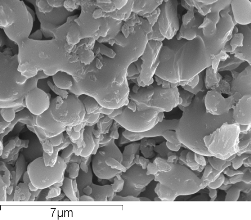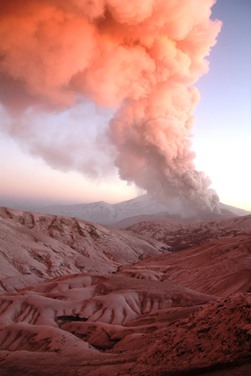 Fabian Wadsworth and Hugh Tuffen* climb into the active crater-source of volcanic glass for the first time, to understand how obsidian forms and flows.
Fabian Wadsworth and Hugh Tuffen* climb into the active crater-source of volcanic glass for the first time, to understand how obsidian forms and flows.
Obsidian is an enigmatic natural volcanic material that has been used by humans throughout archaeological time writes Fabian Wadsworth. It has been used as a precious jewel and a sharp tool, with trade routes extending across continents. Its utility surely derives from the ease with which it can be shaped to purpose while maintaining durability, strength or desirable lustre. It is certainly a material that engenders mystical associations, whether in the form of the dragonglass material’s ability to shatter White Walkers (in George Martin’s Game of Thrones) or John Dee’s (AD 1527-1608) occult mirror tool (British Museum item M&ME 1966, 10-1,1). Yet despite its long history of use and fascination, the processes by which this volcanic glass forms have only recently received close scientific attention.
Picture: January 2012. The steam-and-ash plume rises over the ridge from the volcano’s vent at dusk.
Eruption
Volcanic glass is a rare material that can record much of its own history - from before its formation, to its flow behaviour, eruption characteristics, deposition at surface, subsequent cooling, erosion, burial and use by people. As such, each piece of obsidian contains a wealth of information that may span centuries. This ‘information richness’ draws volcanologists from across the globe to places where obsidian is formed. One such place is Cordón Caulle in Chile.
Before 2008, no obsidian-forming eruption had been witnessed and studied. That changed when Chaitén volcano (Chile) erupted violently, forming an obsidian-rich volcanic dome in a large crater. Shortly after, in 2011, not far from Chaitén, Cordón Caulle re-activated and erupted a long tongue of flowing, liquid obsidian1. That eruption continued into 2013, and the obsidian lava remained sufficiently hot to keep flowing for another year, finally halting sometime later in 2013.
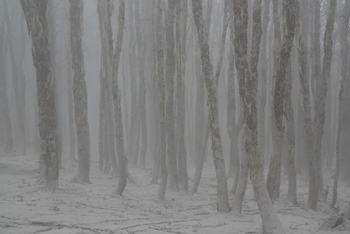 These two events marked a turning point in our understanding of obsidian-producing volcanoes. The most revealing observation was that obsidian is often slowly pushed out of the volcano’s vent as a lava while, simultaneously, large explosions produce huge quantities of volcanic ash (itself tiny shards of volcanic glass). It had been thought that these different eruption styles, violent explosive and more-gentle effusive, were separated in time by a shift in eruption dynamics. Now we know that obsidian is intimately linked to explosions.
These two events marked a turning point in our understanding of obsidian-producing volcanoes. The most revealing observation was that obsidian is often slowly pushed out of the volcano’s vent as a lava while, simultaneously, large explosions produce huge quantities of volcanic ash (itself tiny shards of volcanic glass). It had been thought that these different eruption styles, violent explosive and more-gentle effusive, were separated in time by a shift in eruption dynamics. Now we know that obsidian is intimately linked to explosions.
Picture: January 2012. The forested land on the trail to the volcano is smothered in volcanic ash from the eruption.
In fact, according to work published by Jonathan Castro and colleagues, all obsidian forms from such explosive events, which are the only way that the thick volcanic magma can lose the excess volatile phases that build up pressure in the system below the surface2. This proposition has led to a new view of obsidian-forming eruptions wherein cycles of explosive pulverisation of volcanic glass subsequently heal back into dense glass. It is believed that during this process, all excess gases and volatiles rush out into the atmosphere, carrying with them some of the pulverized shards of volcanic glass in the form of volcanic ash.
So how can magma be pulverized into shards of volcanic glass and then fuse back again into
Obsidian? Volcanic liquids are usually highly viscous when they reach the Earth’s surface, due to several factors. First, they have cooled during ascent through the crust; second, they have lost much of the water dissolved in the liquid, and third, crystals may have formed - all of which act to increase viscosity. When liquids become very viscous they can start to exhibit interesting properties.
Viscoelasticity
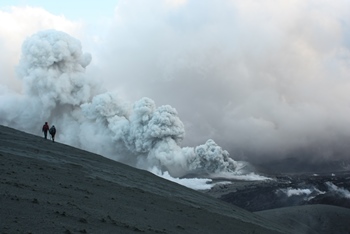 The most important of these is viscoelasticity, a transitional state between liquid-like and solid-like behaviour. When liquids are viscoelastic, rather than simply viscous, they have a propensity to respond to a stress like a glass, rather than like a liquid. In that moment, they can fracture and shatter into small shards. This is known as a glass transition phenomenon.
The most important of these is viscoelasticity, a transitional state between liquid-like and solid-like behaviour. When liquids are viscoelastic, rather than simply viscous, they have a propensity to respond to a stress like a glass, rather than like a liquid. In that moment, they can fracture and shatter into small shards. This is known as a glass transition phenomenon.
Picture: January 2012. The plume is swept over by strong winds as Jonathan Castro and Ian Schipper walk toward the obsidian lava flow front.
Like most interesting physical processes, this can be thought of as the competition between two timescales. First, the flow (either a lava flow or the flow of liquid through the crust on its way to surface) is moving with a velocity, which is associated with a particular timescale. Second, the liquid itself takes a particular amount of time to dissipate stresses that build up. This second timescale gets longer as the temperature of the liquid decreases, or if dissolved magmatic water is lost.
One of the simplest, but most powerful volcanological concepts, is this: if the first timescale is much longer than the second, then the magma will behave dominantly as a liquid. If, however, the second timescale is much longer than the first, then the magma can behave as a solid and can shatter. Most hot obsidian-forming liquids arrive at the Earth’s surface at temperatures and with velocities which mean that the liquids straddle this viscoelastic glass transition and can both flow and fracture in cycles.
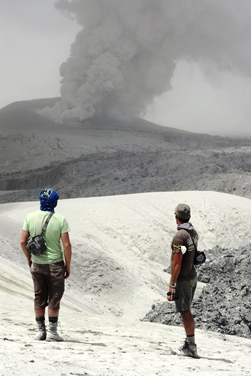 Once shattered, however, these still-hot materials can relax back into a liquid-like state. When this happens, an interesting situation arises where a ‘granular liquid’ exists. A granular liquid that is as sticky as magma will stick back together, or ‘heal’. This process of shattering, relaxation and finally healing seems to occur rapidly and repeatedly in obsidian-forming volcanoes. This is how we might find a piece of dense, pure, shiny black volcanic glass at the Earth’s surface without knowing that at some depth below, it was shattered and healed over and over again. This underpins the findings of Jonathan Castro and his colleagues.
Once shattered, however, these still-hot materials can relax back into a liquid-like state. When this happens, an interesting situation arises where a ‘granular liquid’ exists. A granular liquid that is as sticky as magma will stick back together, or ‘heal’. This process of shattering, relaxation and finally healing seems to occur rapidly and repeatedly in obsidian-forming volcanoes. This is how we might find a piece of dense, pure, shiny black volcanic glass at the Earth’s surface without knowing that at some depth below, it was shattered and healed over and over again. This underpins the findings of Jonathan Castro and his colleagues.
Picture: January 2012. The dark black obsidian appears grey when coated with volcanic ash. Jon Castro and Ian Schipper look to the cone and vent from which the obsidian is being squeezed.
The time required to heal the granular liquids resulting from these fracturing events is the subject of much study at the moment. The times involved in this process are inherently linked to the size of the shattered particles formed, and the temperature at which they reside inside the volcano. The smaller the particle formed or the hotter the magma, the faster the process. This healing process – called ‘viscous sintering’ or ‘viscous welding’ – is critical to understanding how long these shattered fractures can remain open and thus act as channels for gas-escape.
This concept underlies the currently accepted explanation for why these high viscosity magmas explode in huge shattering events, and goes some way towards explaining the textures and observations found at Cordón Caulle volcano. We hope that future models of fracturing and welding cycles will help us to understand how quickly the magma has to de-gas in order to avoid catastrophic explosive eruptions – the result of inefficient outgassing and pressure build-up beneath the Earth’s surface.
Collaborative
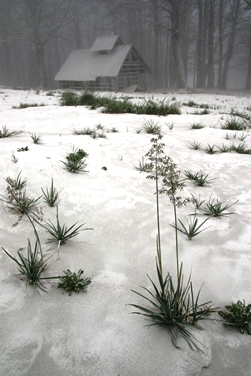 To this end, since 2011 an international collaborative effort, begun with Jonathan Castro and Ian Schipper’s first trip, has focused on Cordon Caulle. In 2014, this interdisciplinary team camped on the south side of the lava and, early one January morning, hiked to the centre of the complex and into the still-active volcanic vent. The vent area was no longer host to explosive eruptions but the ash-laden ground still shook with sub-volcanic seismicity and the gas output from fumaroles still warranted the wearing of breathing equipment. By midday the science team was on the crater floor, walking on the obsidian that had most recently been squeezed out during the effusive eruptions. These deposits of volcanic glass are at the very mouth of a volcano which, only a year before, was exploding violently.
To this end, since 2011 an international collaborative effort, begun with Jonathan Castro and Ian Schipper’s first trip, has focused on Cordon Caulle. In 2014, this interdisciplinary team camped on the south side of the lava and, early one January morning, hiked to the centre of the complex and into the still-active volcanic vent. The vent area was no longer host to explosive eruptions but the ash-laden ground still shook with sub-volcanic seismicity and the gas output from fumaroles still warranted the wearing of breathing equipment. By midday the science team was on the crater floor, walking on the obsidian that had most recently been squeezed out during the effusive eruptions. These deposits of volcanic glass are at the very mouth of a volcano which, only a year before, was exploding violently.
Picture: January 2012. Some plants survive the ash.
There, they found textures that had not been investigated previously - textures that support the conjecture that all obsidian arises from vigorous explosive pyroclastic activity and subsequent healing. Large fractures in the obsidian lava at the source itself were open and coated in red, oxidised veneers. In detail, under a scanning electron microscope, these surfaces are revealed as coatings of volcanic glass shards frozen in the process of healing to the glassy walls.
These provide us with a snapshot of the explosive part of obsidian’s history. While similar features have been seen within older, deeper, now-exposed obsidian features in Iceland3, this exciting observation at Cordón Caulle volcano allows the first link between observations of the eruption itself with observations of the products preserved shortly after the eruption ceased.
Understanding this process of how these particularly high-viscosity magmas lose their volatiles in a complex combination of explosions and effusive activity, is the key to understanding Earth’s most dangerous volcanoes. For example, traditional models of volcanic degassing involve the formation of bubbles. These coalesce in foamy regions and provide permeable pathways for highly pressurised gas to escape – avoiding explosions. However, key work has now changed that view.
Often, bubbles cannot form or grow sufficiently simply because the magma is too viscous. In such cases, the magma may break and shatter instead. Shattered zones may be another way to form permeable channels for dangerously high-pressure gas to escape. However, in this model, gas escapes in a vigorous explosion, rather than without one. That key distinction appears to be congruent with the observations at Cordón Caulle made by the team in 2011-2013.
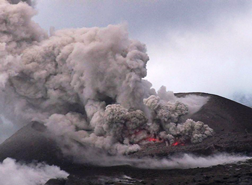 Volcanologists from the University of Lancaster (UK), Ludwig-Maximilians-Universität (Germany), Johannes Gutenberg Universität (Germany) and Victoria University (New Zealand), with other collaborators worldwide, are working to understand this phenomenon further.
Volcanologists from the University of Lancaster (UK), Ludwig-Maximilians-Universität (Germany), Johannes Gutenberg Universität (Germany) and Victoria University (New Zealand), with other collaborators worldwide, are working to understand this phenomenon further.
Picture: January 2012. Close up to the vent. Our unique observations provided evidence that the hot explosions occurred simultaneously with the effusion of obsidian lava. Violent activity and creeping lava flows are, in fact, coincident
Towards prediction?
Currently, it is not possible to predict a volcanic eruption. However, great strides have been made to understand how this might be achieved in the future. A paradigm shift occurred when seismologists discovered that much of the seismicity they were recording at the Earth’s surface around volcanoes was in fact produced in these unseen fracturing and shattering events happening up to a kilometre or more below.
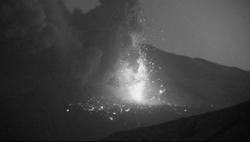 Picture: January 2012. At night, a thermal camera highlights the heat of the pyroclasts ejected from the vent.
Picture: January 2012. At night, a thermal camera highlights the heat of the pyroclasts ejected from the vent.
When a shattering event occurs, it produces a large amount of seismic energy which is transmitted through the Earth’s crust and recorded by seismometers. Once filtered, volcano-seismologists can track these. If seismicity accelerates, an eruption usually occurs. Recent work has suggested that these obsidian forming eruptions may be inherently less predictable than other eruptions. This work suggests that if the seismicity originates from the breaking of the magma itself, then catastrophic fracturing in pure obsidian is particularly challenging to predict. However, when the magma is not obsidian and contains just a small number of crystals, or bubbles (such as at andesitic volcanoes near subduction zones) the prediction of catastrophic events drastically improves.
Although our predictive tools are improving, they are far from operationally viable. Observation of magma fracturing, such as were made at the vent of Cordón Caulle volcano in 2014 and 2015, provide first-hand constraints on these processes.
Environmental impact
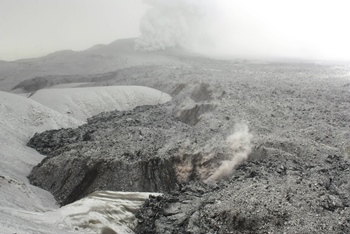
Picture: January 2012. The black lava is coated with ash and the far-off vent roars violently. The lava closest to us crackles and creaks like a hot black glacier. The sound of fracturing magma reminds us that liquids in volcanoes can break like solids.
Cordón Caulle volcano erupted on 4 June 2011, developing a c.9-12 km high volcanic ash column in the first four days. The ash circled the southern hemisphere. The plume was less high in the following week, rising to between four and nine kilometresand decaying to below six kilometres from 14 June. The changes in height were caused by the eruption’s variable pulsations. It is easy to see how challenging such eruptions can be for civil protection authorities, emergency managers and governments.
As a direct result, about 4000 people were evacuated. Prevailing winds carried the ash plume to neighbouring Argentina, causing widespread disruption. Subsequent phases of explosive activity continued into 2012, frequently affecting aviation locally and across several continents. In South America, the Volcanic Ash Advisory Centre (VAAC), hosted by the National Weather Service of Argentina, is responsible for issuing warnings based on volcanic ash dispersal models. In turn, national civil aviation administrators advise airlines on the atmospheric conditions related to the ash; but ultimately, the decision to fly or not is taken by individual airlines and pilots.
The ash particles are all formed in the fracturing and pulverisation process described above. In fact, volcanic ash particles consist of small particles of volcanic glass with variable amounts of crystal phases or vesicles preserved within them. The hazard posed by these fractured volcanic ash particles on the aviation industry is complex but ultimately comes down to the time- and temperature-dependent viscous sintering process, in which the tiny particles melt and stick to surfaces.
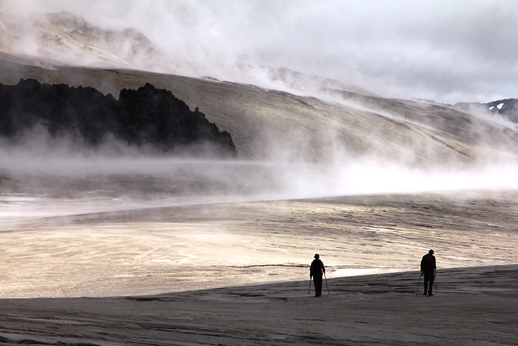 Picture: January 2015. Years later, when the eruption has stopped, mist veils the obsidian lava from view as we hike around to the vent area ready to descend into the mouth of the volcano.
Picture: January 2015. Years later, when the eruption has stopped, mist veils the obsidian lava from view as we hike around to the vent area ready to descend into the mouth of the volcano.
In this case, the surfaces to which they stick are the operational surfaces inside hot commercial jet engines. It has recently become clear that volcanic ash is particularly hazardous to commercial airline industry because the glass transition temperature at which the ash becomes sticky is a lot lower than the melting points of other dust materials which are ingested by jet engines, such as desert sands.
Wonder and awe
These exciting new scientific ideas about obsidian’s formation require thorough testing and discussion. But this does not detract from the wonder and awe that obsidian still engenders. Volcanologists today remain fascinated by the secrets and remaining mysteries of this enigmatic material.
The wealth of history recorded by these enigmatic stones drive us to explore what may seem at first to be arcane theoretical ideas far from everyday concerns. But what we learn leads us closer, we believe, to finding the causes and dynamics of explosive activity, and thus enable us to mitigate the hazards for those who must live under the volcano.
* Earth & Environmental Sciences, LMU, Thereisenstr. 41, 80333 Munich E: [email protected] (Corresponding author). All photos by Hugh Tuffen.
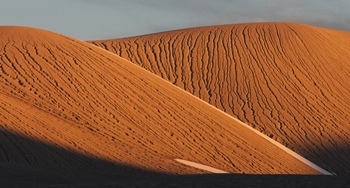 References and further reading
References and further reading
Picture: January 2015. The dynamic landscape into which the eruption intruded is built of steep gullied sands that make hiking very difficult.
- For more photographs of the Cordon Caulle eruption and obsidian please visit and follow Yetirama: http://blog.yetirama.com/a-journey-into-the-cordon-caulle-volcano-1079/
- Castro et al., 2014. http://www.sciencedirect.com/science/article/pii/S0012821X1400510X
- Tuffen et al., 2013. http://www.nature.com/ncomms/2013/131101/ncomms3709/abs/ncomms3709.html%3Fmessage-global%3Dremove
- Schipper et al., 2013. http://www.sciencedirect.com/science/article/pii/S0377027313001790
- Gonnermann & Manga, 2003. http://www.nature.com/nature/journal/v426/n6965/abs/nature02138.html
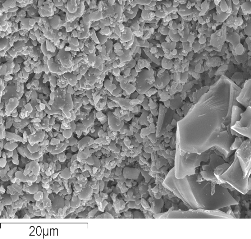
Pictures:Two SEM images (Left, a: Below, b) of sintered volcanic ash particles adhering to fracture surfaces and forming the smooth veneers seen in field outcrops. Magma that is pulverised to a powder of volcanic ash sticks back together again in hot cracks even as it is being violently erupted.
